Osteoporosis Exercise Examples
The following exercises promote good posture, strength, movement, flexibility and balance in healthy people as well as those with osteoporosis. If you’ve recently broken a bone or if you have very low bone density, discuss these exercises with your physical therapist or healthcare provider before trying them and remember to avoid all activities that require bending forward from the waist or too much twisting of the spine.
A little bit of muscle soreness lasting for one to two days after exercise is normal, but none of these exercises should ever hurt in any way while you are doing them or cause soreness for more than one or two days afterward. If you have pain with any of these exercises or are not sure if a certain exercise is right for you, BHOF recommends that you first discuss your concerns with a physical therapist.
These exercises are designed to be done along with a weight-bearing exercise program. They do not replace the need for walking or doing other weight-bearing activities.
For exercises that involve lying on the floor, you may want to place a blanket or thick mat under you for comfort. If you cannot get up and down from the floor, you may do them on a firm bed.
The exercise examples below fall into one of four sections:
A. Posture exercises
These exercises improve your posture and reduce rounded or “sloping” shoulders. They can help you decrease the risk of breaking a bone, especially in the spine.
B. Hip and back (spine) strengthening exercises
These exercises can help you to strengthen the muscles in your back and hips.
C. Balance exercises
These exercises strengthen your legs and challenge your balance. They can decrease your chance of falling.
D. Functional exercises
These exercises improve how well you move. They can help you in everyday activities and decrease your chance of falling and breaking a bone. For example, if you find it hard to get up from a chair or climb stairs, you should do these activities as exercises (try standing up and sitting down several times until you are tired).
While there are only one or two examples for each section, BHOF’s publication (formerly NOF), Boning Up on Osteoporosis, includes a total of 24 exercises with an additional section on safe movement. Learn more about Boning Up.
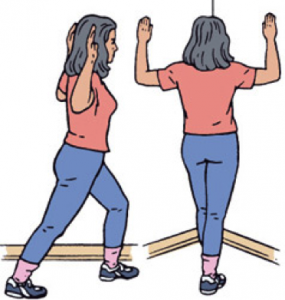
A. Posture Exercise Example
Corner stretch
Stand in the corner of a room with your arms extended to the walls at shoulder level.
- Step one foot forward, letting that knee bend.
- Lean onto the front leg, bringing your head and chest toward the corner.
- Hold for 20-30 seconds.
- Stand up straight and switch feet.
- Repeat it on the other side.
- Do 2 on each side, 3 times per week.
Benefit: Stretches shoulders, flattens upper back. Improves rounded shoulders.
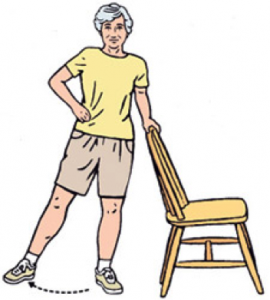
B. Hip and Back Strengthening Exercise Examples
Hip abductor strengthening
- Stand straight and hold onto the back of a chair, without bending at the waist or knee.
- Place other hand on the top of your pelvis and raise this leg straight out to the side.
- Make sure that the toes point forward and your pelvis (and hand) don’t rise up.
- Lower the leg and repeat 10 times.
- Change sides and repeat the exercise with the other leg.
- Do this 2-3 times per week.
- If you can, add an ankle weight that is heavy enough that you cannot lift it more than 10 times.
Benefit: Strengthens the hips. Improves balance.
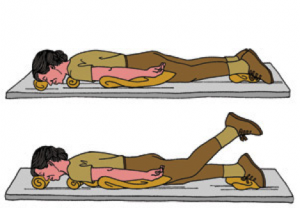
Prone leg lifts
- Lie on your abdomen with hands at your sides.
- Place towels under your forehead and shoulders and a towel or pillow under your abdomen for comfort. (see illustration).
- Bend your right leg slightly and lift your thigh off the floor.
- Keep your foot relaxed.
- Lower and repeat 10 times.
- Then do 10 on the other side.
- Do this 2-3 times per week.
- If you can, add an ankle weight that is heavy enough that you cannot lift it more than 10 times.
- If this causes back pain, try adding another pillow under your abdomen.
Benefit: Strengthens lower back and buttocks. Stretches hip flexors and the front of the thighs.
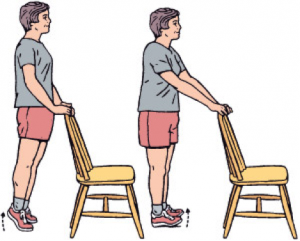
C. Balance Exercise Example
You can improve your balance with the following exercises which can decrease your risk of falling and breaking a bone. These exercises are especially important if you have fallen one or more times in the past year or if you lose your balance when you do normal activities.
When you do balance training exercises, you should feel a little wobbly in your legs and feet, but you should not feel like you could fall. The goal of these exercises is to hold the position for 20-30 seconds and move on to the next level when you no longer wobble.
You may need to hold onto a stable chair or table with both hands at first. When you no longer wobble, hold on with one hand only. As you become steadier, try touching the chair with one fingertip only or hold your hands two inches above the table or chair.
Toe raises/heel raises
- Stand straight and hold onto the back of a chair, without bending at the waist or knees.
- Rise up on your toes and then back onto your heels. When you rise up onto your toes, imagine you are moving your head up to the ceiling.
- Repeat 10 times.
- Hold on to the chair as little as possible to challenge your balance.
- Do this once each day.
Benefit: Strengthens lower legs. Helps balance.
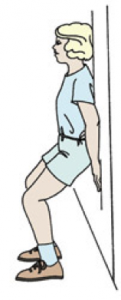
Wall slide
- Stand with your heels one shoe-length from the wall.
- Keep your feet straight ahead and shoulder width apart.
- Place your buttocks, palms of your hands and shoulders against the wall.
- Tuck your chin in so that the back of your head is as close to the wall as possible. Pull in your abdomen the entire time.
- Slide up and down, bending your knees half-way to a sitting position.
- Keep your shoulders back and abdomen flat.
- Keep your back flat.
- Do this 10 times, 2-3 times per week.
Benefit: Strengthens thighs, abdomen and back. Decreases rounded upper back and forward head posture. Improves leg alignment.